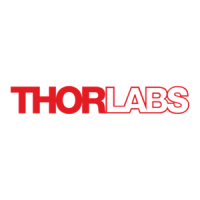© 2016 Thorlabs Scientific Imaging
2 Camera Basics
51
2.6.2 Gain and Offset
Gain
In digital imaging, a voltage proportional to the amount of incident light is output by the sensor. To
increase image brightness and contrast, this signal can be amplified by an analog gain and offset
before the digitizing process. The results of analog signal processing are usually better than the
results of digital post-processing.
Analog amplification of the read-out pixel values increases overall image brightness and contrast.
Depending on the sensor type, a global gain value for all pixels (master gain) or a separate gain
value for each color (RGB gain) can be set.
Note
Using Sensor Gain: A signal gain will also result in a noise gain. High gain settings are therefore
not recommended.
We suggest the following gain settings:
1. Enable the Gain boost function (is_SetGainBoost()).
2. If required, adjust the gain setting with the master gain control.
Note
Linearity of sensor gain: You can set the gain factor in increments from 0 to 100.
For CCD sensors the gain increases usually not linear but disproportionate.
For CMOS sensors the gain increases linear. Some sensors have only 32 or fewer levels, so not
each step is assigned to a level.
The maximum gain factor settings also vary from sensor to sensor (see Camera- and sensor data).
Offset
Every digital image sensor has light-insensitive cells next to the active image area. These dark
pixels are used to measure a reference voltage (black level) which is subtracted from the image
signal. This compensates thermally generated voltages on the sensor which would otherwise falsify
the signals.
Normally, the sensor adjusts the black level automatically. If the environment is very bright or if
exposure times are very long, it may be necessary to adjust the black level manually.
2.6.3 Automatic Image Control
The uc480 driver provides various options to automatically adjust the image capture parameters to
the lighting situation. These include:
Auto exposure shutter (AES)
Auto gain control (AGC)
Auto white balance (AWB)
Auto frame rate (AFR)
The auto functions are used to adjust the average brightness and color rendering of the camera
image to their setpoint values, while trying to keep the frame rate at the highest possible value.
All controls are configured using the is_SetAutoParameter() SDK function.
Auto exposure shutter (AES)
The control of the average brightness is preferably achieved by adjusting the exposure, i.e. you set
the highest possible exposure time before gain is controlled. The auto exposure feature always

